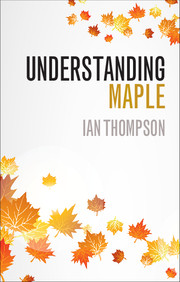
-
Select format
-
- Publisher:
- Cambridge University Press
- Publication date:
- December 2016
- November 2016
- ISBN:
- 9781316809761
- 9781316628140
- Dimensions:
- Weight & Pages:
- Dimensions:
- (216 x 138 mm)
- Weight & Pages:
- 0.33kg, 235 Pages
You may already have access via personal or institutional login
Book description
Maple is a powerful symbolic computation system that is widely used in universities around the world. This short introduction gives readers an insight into the rules that control how the system works, and how to understand, fix, and avoid common problems. Topics covered include algebra, calculus, linear algebra, graphics, programming, and procedures. Each chapter contains numerous illustrative examples, using mathematics that does not extend beyond first-year undergraduate material. Maple worksheets containing these examples are available for download from the author's personal website. The book is suitable for new users, but where advanced topics are central to understanding Maple they are tackled head-on. Many concepts which are absent from introductory books and manuals are described in detail. With this book, students, teachers and researchers will gain a solid understanding of Maple and how to use it to solve complex mathematical problems in a simple and efficient way.
Reviews
'Thompson (Univ. of Liverpool, UK) clearly knows the ‘gotchas’ that most often plague beginners (and others!) and provides pointed guidance; extracting the same vital information buried in longer and more systematic treatises and manuals can certainly prove a challenge. Summing Up: Recommended. Lower-division undergraduates and above; faculty and professionals.'
D. V. Feldman Source: CHOICE
Contents
-
1 - Introduction
pp 1-5 -
-
- You have access
- Export citation
-
Metrics
Altmetric attention score
Full text views
Full text views help Loading metrics...
Loading metrics...
* Views captured on Cambridge Core between #date#. This data will be updated every 24 hours.
Usage data cannot currently be displayed.
Accessibility standard: Unknown
Why this information is here
This section outlines the accessibility features of this content - including support for screen readers, full keyboard navigation and high-contrast display options. This may not be relevant for you.
Accessibility Information
Accessibility compliance for the PDF of this book is currently unknown and may be updated in the future.


